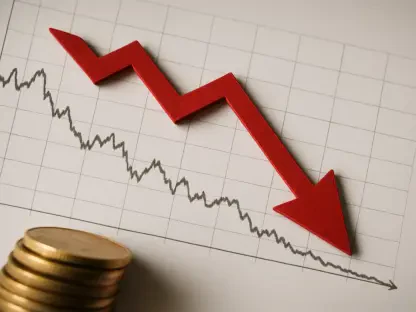Recent weeks have seen notable declines in the stock market, culminating in a massive sell-off. Approximately $5 trillion in market capitalization of the S&P 500 was erased, forcing the index into correction territory. This turbulence has been driven largely by worries over President Trump’s trade policies and mounting concerns about a potential recession in the US. The large-scale exodus from the market has left investors scrambling and has set the stage for intense speculation about the future direction of the stock market.
Optimistic Outlook from Major Banks
Predictions from Morgan Stanley and Citi
Major banks, including Morgan Stanley and Citi, offer an outlook that injects some optimism into the prevalent market gloom. They believe the worst of the sell-off could be over, pegging 5,500 as the floor for the S&P 500. This perspective comes with a year-end price target of 6,500, suggesting a potential upside of 15%. Analysts from these banks pinpoint several factors reinforcing their view, such as improved sentiment and favorable seasonal indicators. The consensus is that the market will stabilize and even rally by the end of the year.
Morgan Stanley and Citi base their forecasts on the assumption that conditions around the S&P 500 will continue to be favorable. They highlight the benefits of a weaker US dollar, which tends to bolster corporate earnings from international operations by making American products and services more competitive abroad. Additionally, lower interest rates could fuel economic surprise indexes, traditionally a good sign for stock recoveries. These predictions rest on existing economic indicators and trends continuing along their current trajectories without significant disruptions.
Factors Supporting Optimism
There are several underlying reasons for the banks’ optimistic projections. Seasonal trends are known to become more favorable in the latter half of the year, ostensibly providing a boost to market morale and activity. For instance, a weaker dollar can have a significant positive impact on earnings for companies with substantial international revenue streams. This can lead to upward revisions in earnings forecasts, which generally supports higher stock prices. Lower interest rates are also anticipated to spur economic activity and enhance the economic surprise indexes.
Moreover, technology stocks, particularly those within the group known as the Magnificent Seven, are perceived to be more reasonably valued now. The correction has led to a revaluation that some analysts argue is healthier for the S&P 500’s overall earnings multiple. This realignment could pave the way for more sustainable growth within the tech sector, pushing the index higher. Improved market sentiment and positioning gauges also support the case for a rebound, suggesting that the market is oversold and poised for a recovery.
Cautious Takes and Bearish Views
Skepticism from Other Analysts
Despite the optimistic outlooks from Morgan Stanley and Citi, there remains considerable skepticism from other market analysts. Goldman Sachs and RBC, for example, have taken a more cautious stance by downgrading their price targets for the S&P 500 to 6,200. This more tempered outlook reflects ongoing concerns about policy uncertainties and potential economic slowdowns. The bearish projections indicate a realistic assessment of the market’s volatile state, emphasizing that further declines could be on the horizon if the economic data does not improve.
Entities like Citi, while optimistic, also caution about a bear case scenario where the S&P 500 could drop to 5,100 if growth fears persist. Morgan Stanley, in an even more bearish scenario, posits a potential drop to 4,600 in the event of a recession. This outlook underscores the fragility of the current economic climate and highlights the significance of certain key support levels for the index. These divergent opinions illustrate the complexity of market forecasting, where optimism is tempered by a realistic appraisal of potential risks.
Importance of Key Support Levels
The importance of the S&P 500 responding positively to the 5,500 level cannot be overstated. Holding this support is crucial for maintaining both fundamental and technical integrity. A failure to stabilize at this level could lead to further declines and heightened market volatility. It’s important for investors to watch how the index performs at these critical junctures, as they can significantly influence broader market sentiment. A breach below 5,500 could signal further economic distress and lead investors to reassess their strategies.
The potential for volatility is real, and the broader economic conditions remain precarious. Key support levels act as psychological barriers and often influence trading behavior. If the market fails to uphold these levels, the risk of a sell-off becomes more pronounced, affecting investor sentiment and potentially leading to more substantial declines. The fragility of these support levels serves as a stark reminder of the market’s inherent unpredictability and the need for continual vigilance among market participants.
No Immediate Relief from Government Actions
Lack of Government Intervention
The Trump administration has shown a clear reluctance to engage in direct intervention to stabilize the stock markets. Treasury Secretary Scott Bessent has publicly stated that market corrections are a normal and even healthy aspect of market cycles, denoting a preference for allowing the market to self-correct. This approach suggests that investors should not expect short-term relief measures from the government. The administration’s stance on potentially entering a recession, with a focus on long-term economic gains rather than immediate stabilization, adds another layer of complexity to the situation.
President Trump’s comments reflect a broader economic philosophy that prioritizes long-term structural adjustments over short-term market interventions. This has significant implications for how investors and analysts approach the current market environment. Without the prospect of government intervention, market forces are left to their own devices, leading to potentially higher volatility and uncertainty. This hands-off approach underscores the administration’s commitment to long-term economic reform rather than quick fixes.
Long-Term Strategies Over Immediate Solutions
In recent weeks, the stock market has experienced significant declines, culminating in a massive sell-off that erased roughly $5 trillion in market capitalization from the S&P 500. This drastic drop has pushed the index into correction territory. The unsettling market activity has been primarily driven by concerns surrounding President Trump’s trade policies, which investors fear could negatively impact global trade and economic growth. Additionally, growing apprehensions about a potential recession in the US have exacerbated the situation, leading to widespread panic and an exodus from stocks. As a result, investors are anxiously trying to navigate these turbulent times, with many speculating intensely about the future trajectory of the market. Analysts and traders alike are now focused on economic indicators and policy decisions as they attempt to forecast whether this downturn is merely a temporary setback or a precursor to a more prolonged period of economic trouble.









